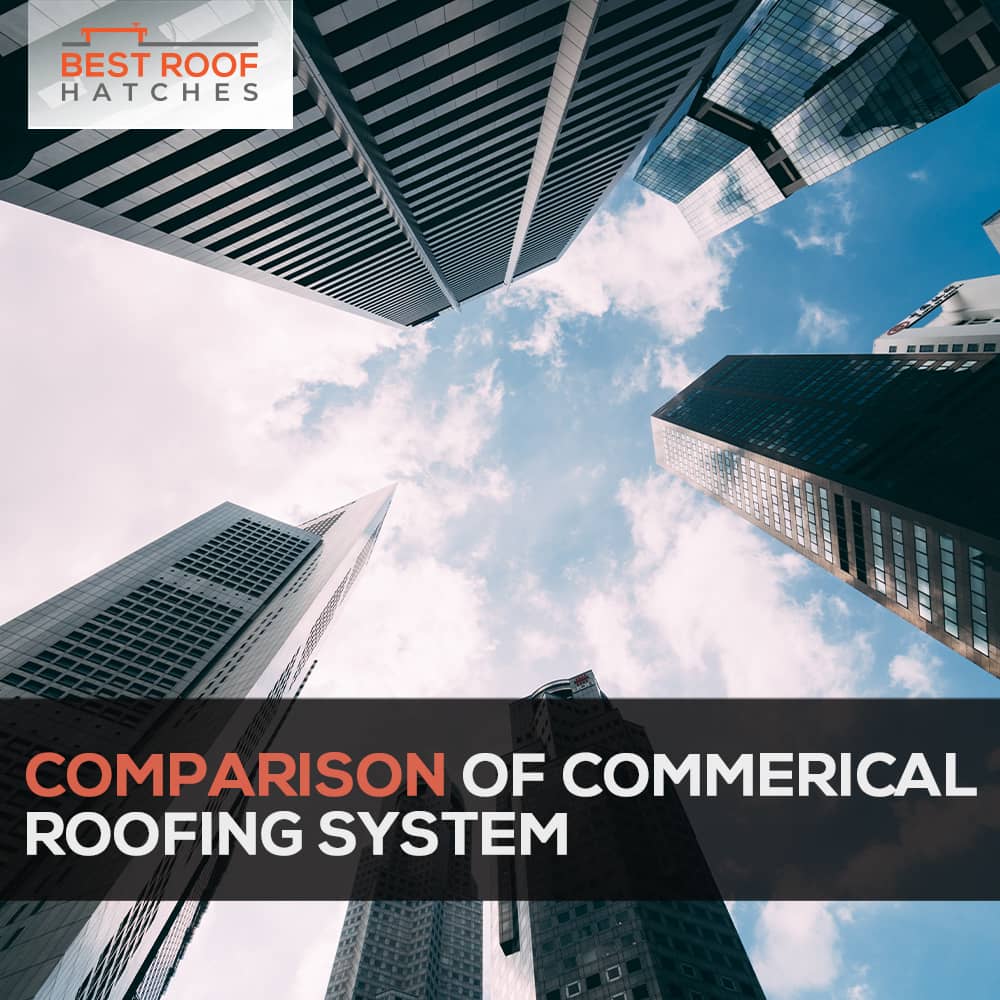Share this
Comparison of Commerical Roofing System
Posted by Best Roof Hatches on 2020 Dec 1st
Choosing the right commercial roofing system can be challenging when there are so many different kinds and factors to consider. Some of these are your area's topography, your industry, and your main reason for installing the roofing system. Aiming to help, Best Roof Hatches has compiled a list of the different commercial roofing systems with their respective advantages and disadvantages. We will give an honest overview of the common roofing types, including their materials, costs, and designs. Aside from that, we will compare them depending on their installation difficulty.
Metal Roofing
One of the most common types of commercial roofing is metal because of its convenience. If properly maintained, metal roofing can last up to 50 years, which is very cost-effective for the property owner. Metal is comparably lighter than other roofing materials, making it easier to install. Installation usually takes about two days, which cuts down on labor costs. The cost of metal roofing is $150 per hundred square feet on average.
One great benefit of metal roofing is its fire-resistance, which can be a protection for your building. It can also deflect heat, which is very convenient during the hot summer months. However, metal commercial roofing products do not help with soundproofing. When it rains, you may have to adjust to hearing the sound of every raindrop hitting your roof. In terms of durability, a metal roof may also suffer damage from hailstorms. As long as it is adequately maintained, you can avoid corrosion so that water doesn't leak through at weak metal points.
Asphalt Shingle Roofing
When it comes to affordability, asphalt shingle roofing comes first in the list of commercial roofing systems. Asphalt shingles only require minimal maintenance costs and can last at least 15 years, providing adequate barrier protection and general durability. Aside from that, this commercial roofing material comes in various colors to match the property's design. It is very convenient to install and only takes up to two days to complete.
However, one of the disadvantages of asphalt shingle roofing is its lack of heat-resistance. Asphalt shingles can easily crack and break when exposed to higher-than-average heat, which is not ideal for buildings located in warmer climates. If your building's location experiences extreme summer weather, you should consider using other types of commercial roofing systems. Moreover, this material is not environmentally-friendly and not recyclable. To aim for a green building, consider installing our next course on the list.
Green Roofing
One of the latest trends today is using green roofing designs to avoid environmental hazards for buildings. These commercial roofing systems use recycled/recyclable and energy-efficient materials and natural insulation, which controls energy consumption and utility costs. Green roofing allows for a comfortable temperature in attic spaces as it can force heat away from the building. It gets bonus points for its noise-reduction capabilities. To enhance sustainability, installing an eco-friendly roof hatch from Best Roof Hatches is also recommended.
Green roofing materials do require a larger budget. In general, green roofing materials cost more to buy and to install. A green roof also requires more intensive maintenance as it needs regular pest and insect mitigation to avoid damage.
Thermoplastic PVC Roofing
Using Thermoplastic PVC roofing for your commercial property can be a cost-effective choice. You will only need to spend around $7000 for the installation. Moreover, it comes in different designs and colors, which gives you flexibility in styling your roof. Depending on your preference, these commercial roofing products can also be heat-reflective that will lower your energy consumption. Mould, moss, and mildew are also not a problem since it does not grow on PVC. It is also resistant to environmental elements that could damage your roofing system.
However, like the first two types of commercial roofing systems, it is not ideal for places that experience excessive heat, resulting in cracking. This type of roofing system is practical in terms of being lightweight, but it's not the material of choice if you need a roof that can withstand a lot of weight. It can also experience thickness disparities upon installation. For this type of roofing system, it is advisable to monitor the structure properly to avoid future complications.
Thermoset EPDM Membrane Roofing
Thermoset EPDM membrane roofing could be the best system for you if you need a roof that will last for up to 60 years. Membrane roofing has three types of insulation: expanded polystyrene, extruded polystyrene, and polyisocyanurate. This commercial roofing system offers retentive and reflective properties that are very efficient. Aside from reflecting the heat away during summer, it can also retain the heat during the winter and take the pressure off your HVAC system. You should also note that this roofing is relatively lightweight and flexible, allowing easy installation and maintenance.
Although economical, the membrane is not that sturdy. You may need more maintenance as the seams may develop leaks more frequently than other roofs. Moreover, its adhesives are easy to break apart by ultraviolet sunray exposure.
We hope our comparison of commercial roofing systems brings you one step closer to choosing the ideal solution for your roof. Once you've decided, be sure to pick out one of our roof hatches to make roof access easy, convenient, and safe. To learn more about our roof hatches, visit Best Roof Hatches online or call us!

